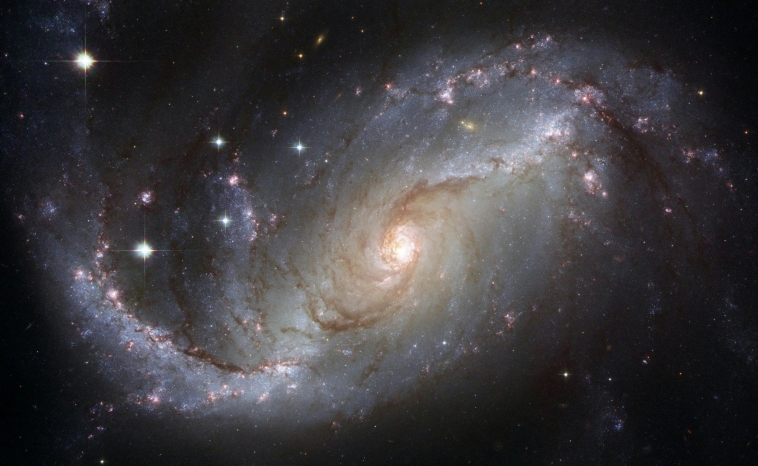Why Is Space Black?

Why is space black? Explore the intriguing science behind the universe’s darkness and gain insights into the nature of light and cosmic phenomena.
When you take the time to gaze at the night sky, chances are you’re focusing on things like stars, planets, and, with a little luck, maybe even meteors. But what about all the space in between those objects? The universe is filled with stars, galaxies, and nebulae that glow in all manner of breathtaking colours. Yet, the backdrop to this cosmic display is an expanse of deep, inky darkness. So, why is space black?
That’s where this article comes in! Join us as we take a closer look at the very fabric of space and try to get to the bottom of exactly why space is black!
The Nature of Darkness in Space

To understand why space is black, we first need to explore what darkness actually is. You see, as humans, we’re very good at recognising ‘things’. It’s just how our minds work. And that’s fine when we can look at something like a star, or a planet, or a cat, and say “Oh, that’s something”. But the darkness of space isn’t a tangible thing. It’s the absence of light. It’s not something – it’s nothing.
Here on Earth, darkness is a fleeting phenomenon. The Sun’s rays bathe our planet in light during the day, and even at night, the Moon and artificial lights chase away the gloom. But space? Now that’s a different story entirely.
Space is vast. Mind-bogglingly vast. It’s mostly made up of vacuum, meaning there’s very few particles to scatter or reflect light. And without something to bounce off, light will indefinitely travel in a straight line. So, unless you’re looking directly at a light source, like a star, your eyes won’t perceive anything. Hence, the blackness of space.
Then there’s the small matter of how our eyes work. To see an object, light has to enter your eyes and stimulate the photoreceptor cells in your retinas. When you look at the night sky, only the light from bright objects like stars and planets reaches your eyes. The rest of space, where light doesn’t directly hit your retinas, appears black.
Interestingly, if you were to stand in space with no atmosphere to scatter light, even the Sun’s rays wouldn’t illuminate the surrounding void. Instead, the Sun would appear as a blindingly bright point against a pitch-black backdrop. That’s why astronauts see a black sky even when orbiting Earth in broad daylight.
Why Is Space Black and Not Completely Bright?

At first glance, it might seem like the universe should be blazing with light. I mean, there’s literally trillions of stars scattered right across the cosmos. Surely their combined glow should make space a dazzling spectacle?
This question, known as Olbers’ Paradox, puzzled astronomers for centuries. But the answer lies in the nature of the universe itself. For starters, the universe is not infinite in age. In fact, it’s about 13.8 billion years old. Now, that’s important, because it means the light from stars farther away than 13.8 billion light-years hasn’t had enough time to reach us yet.
What’s more, the universe is continually expanding. As it grows, it stretches the light from distant stars into longer wavelengths that are no longer visible to the human eye. This phenomenon, called redshift, also contributes to the darkness of space.
Cosmic Voids: The Dark Side of the Universe
Astronomers estimate there to be 200 billion galaxies in the observable universe, filled with trillions of stars. But despite these massive figures, they’re still vastly outnumbered by empty regions called cosmic voids. These mammoth spaces, some spanning hundreds of millions of light-years, contain hardly any matter at all.
Cosmic voids are another key reason why the universe appears black. Even though light travels through these regions, there’s just nothing within them to emit, scatter, or reflect that light. As a result, they don’t alter the straight-line travel of light passing through, and instead contribute to the swathes of darkness that dominate our view of the cosmos.
Why Is Space Black – The Role of Light Physics
Compared to right here on Earth, light behaves differently in space. On our planet, the atmosphere scatters sunlight, creating the bright blue sky we see during the day. But in space, there’s no atmosphere to do this. As we’ve already mentioned, light travels in straight lines until it interacts with an object, like a planet, moon, or spacecraft. So, without something like an atmosphere to scatter or diffuse it, light doesn’t ‘fill’ space the way it fills our sky.
Also, it’s worth considering the wavelengths of light. Visible light makes up just a tiny fraction of the electromagnetic spectrum. Much of the light in the universe exists in wavelengths that are invisible to human eyes, like infrared, ultraviolet, and X-rays. So, even though space is brimming with light, much of it simply isn’t visible to us!
Does Space Have Colour?
Technically, space isn’t black – at least not entirely. If you could perceive the full spectrum of light, space would appear to glow faintly. That’s because of something we call the cosmic microwave background radiation, a remnant of the Big Bang. This radiation isn’t visible to the naked eye, but it is detectable with special instruments and provides a “ghostly” backdrop to the universe.
And as we discussed earlier, space is often lit up with fascinating colours that we can’t see with our limited human eyes. But thanks to modern telescopes, like the incredible James Webb Space Telescope, we can capture images of space objects like nebulae and catch a glimpse of them through a different light wavelength, like infrared. If we could see these different wavelengths with our own eyes, space would certainly look a little different!
Why Is Space Black – Final Thoughts
It might seem counterintuitive that a universe filled with stars and galaxies could appear so dark. But the interplay of physics and our own perception helps to create this striking phenomenon. So, if you’ve ever felt a twinge of existential awe while staring into the night sky, remember that the darkness of space isn’t just an imposing canvas. It might literally be nothing, but it’s that nothingness that makes all of the something so special!
Find Light in the Darkness with the OSR One Million Stars App

Curious to navigate the stars yourself? Check out the OSR One Million Stars app and uncover the wonders of the night sky. Whether you’re seeking out twinkling stars or simply want to enjoy the beauty of the cosmos, our app is your ultimate guide to exploring the universe!

